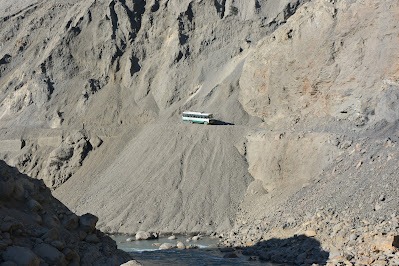
Image source: Praveen
Sumdo village is an important gateway to the stunning landscapes of the Spiti region. A remote settlement in the extreme part of Spiti valley lies near the Indo-Tibetan border in Himachal Pradesh. Located amidst towering snow-covered peaks, rugged mountain ranges, and sparse high-altitude vegetation, Sumdo is a perfect destination for travellers who are seeking experiences away from conventional tourist circuits.
Geography
Sumdo village, officially known as Dhar Sumdo, is situated approximately 140 kilometres away from the district headquarters at Kaza. The name “Sumdo” itself appears in multiple locations across the Himalayan region, including another Sumdo in Kinnaur district and one referenced in Tibet Autonomous Region, China, that leads to confusion among travel literature.
Manali serves as the nearest major town to Dhar Sumdo for all significant economic activities, despite the considerable distance between them through mountainous terrain. A geographic isolation of the Sumdo village contributes to the village’s preserved cultural identity and relatively untouched natural environment.
Landscape and Natural Features
Sumdo’s dramatic topography is typical of the high-altitude Himalayan desert ecosystem found throughout Spiti. The village is perched amidst grand snow-covered peaks, rugged mountain ranges, rocky hills, and sparse mountain vegetation. The village is positioned near river valleys that are characteristic of the Spiti region, with the larger Spiti River system being a dominant feature of the broader area.
Yet this breathtakingly beautiful environment creates a stunning backdrop that attracts adventure travellers and nature enthusiasts. The surrounding mountains not only provide spectacular views but also contain numerous trekking routes that use Sumdo as a starting point or important waypoint.
Tourism and Trekking Opportunities
Sumdo village has emerged as an important destination for adventure tourism, particularly for trekking enthusiasts. Its position as a remote outpost near the border makes it an excellent base camp for several challenging trekking routes that explore the surrounding valleys and mountain passes. The village provides thrilling trekking experiences for adventurers who wish to explore the less-traversed paths of the Himalayas.
Cultural of Sumdo
The information about the culture of Sumdo is limited but it can be seen in the broader cultural context of the Spiti valley which has a rich Buddhist heritage.
The Spiti region is known for its “intensely introvertive culture centred around its several monasteries,” including Dhankar, Ki, Tabo, Mud, Gungri, Lidang, Hikim, Sagnam, Mane Gogma, and Giu. Majority of the people in the Spiti region follows the Geluk-pa sect and this Buddhist cultural influence likely extends to Sumdo as well.
Accessibility and Travel Information
Travellers planning to visit Sumdo first have to reach Manali or Shimla and then take a long road trip through mountainous terrain. Sumdo remote location prevents it from becoming overdeveloped for tourism. The roads to sumdo remains unaccesible durig the winter months when the region receives heavy rainfall.
Nearby Attractions
Sumdo’s location makes it a gateway to explore other interesting locations in the region. Nearby villages like Chango offer additional opportunities to experience local culture. The surrounding area contains numerous natural attractions, including dramatic mountain passes, high-altitude lakes, and pristine valleys that have seen little tourism development.
Nearby villages like Chango offer additional opportunities to experience local culture.
In the broader Spiti Valley, Buddhist monasteries like Ki Gompa, which is one of the most famous monasteries in the region, are relatively accessible from the main Spiti road network that eventually connects to Sumdo.
